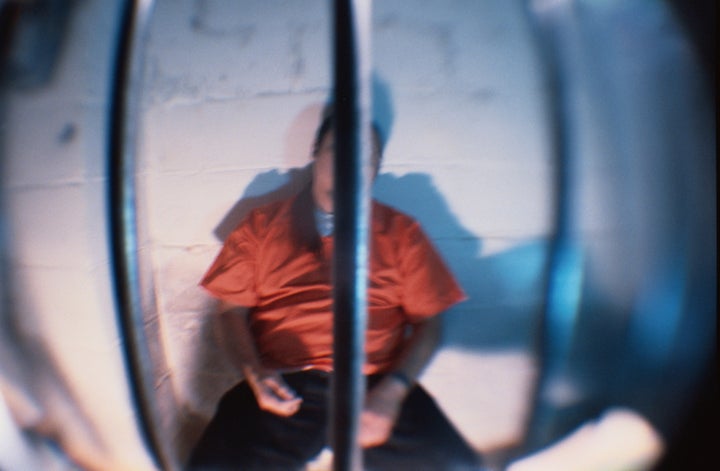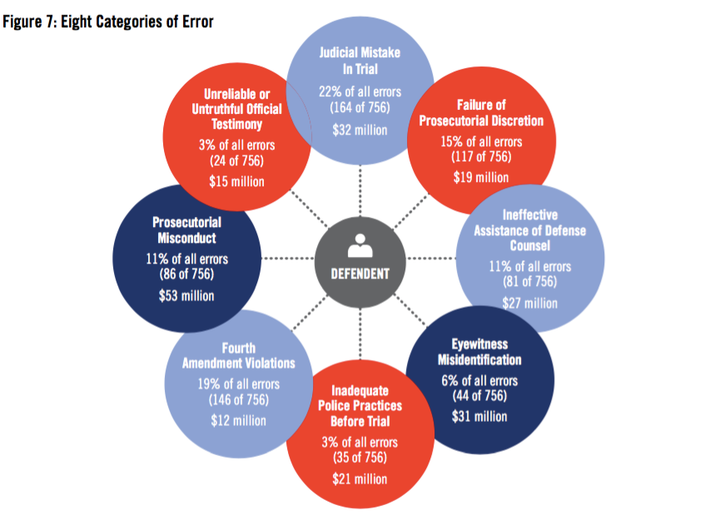
LOS ANGELES -- California has squandered hundreds of millions of tax dollars on faulty convictions that have led to people collectively wasting hundreds of years behind bars, according to a new report on the state's criminal justice system.
Researchers examined 692 failed adult felony convictions that occurred in the state between 1989 and 2012, and released their findings Wednesday in a blistering report. A failed conviction is one that is later reversed or dismissed due to a number of legal problems, including an innocent person being wrongfully charged in a crime they did not commit; a judge, prosecutor or police officer committing misconduct or error during a case; or a case being built on the back of faulty or incomplete evidence.
These flawed proceedings have cost California taxpayers more than $282 million, according to the "Criminal (In)Justice" study, which was released by the Chief Justice Earl Warren Institute on Law and Social Policy at the University of California, Berkeley School of Law.
In part, these millions of dollars come from expenses incurred from incarcerating people with faulty convictions and settlements in lawsuits over these errors. The slew of legal proceedings that led up to these faulty convictions -- including hundreds of jury trials, dozens of mistrials and hung juries and more than 700 appeals and petitions -- were also costly.
The researchers took a novel approach in the sample cases they included: Rather than focusing solely on wrongful convictions, they also included defendants who were found "not guilty" or whose convictions were ultimately dismissed. For various reasons, the state could not prove these people -- who may or may not be innocent -- had committed a crime.
"The bottom line is every case we included was someone who was targeted, arrested, prosecuted, convicted, almost always incarcerated -- for sometimes a long period of time -- and at the end of the day they went home without a conviction," Rebecca Silbert, report co-author and senior vice president at the Opportunity Institute in Berkeley, California, told The Huffington Post.
"In some of those cases they clearly didn’t do it, in some of those cases it’s not as clear, but it’s a problem either way," she said.
By far, the most expensive flawed convictions that were later reversed or dismissed were in homicide cases -- more than half of all the costs in the report originated from failed homicide prosecutions.
If held back-to-back and nonstop, the reversed and dismissed cases detailed in the report would keep a single courtroom with a full staff of judges, juries and attorneys working for more than 20 years, the researchers note.
But the tax dollars spent represents only a fragment of the total damage done. The nearly 700 individuals who were subjected to these failed prosecutions perhaps paid the ultimate price -- collectively, they lost over 2,000 years in jails or prisons.
But that’s just the beginning of their problems. Employers can see if a job applicant has been sentenced to prison, but can't always find out if he or she has been dismissed due to a faulty conviction. Formerly incarcerated people who do get jobs tend to have significantly diminished incomes, even long after leaving prison. And children of people who have been incarcerated are likely to be stigmatized, suffer long-term emotional and behavioral challenges, and have a greater chance of living in poverty or general instability at home.
"The individuals in this report were often incarcerated in the prime of their lives, in the time when they could have been getting an education, starting a career, and building a family," the report states.
And flawed convictions are not resolved quickly. In the hundreds of cases researchers examined, defendants fought on average for four and a half years before their convictions were finally dismissed. In about one-quarter of all the cases, more than five years passed between the first appearance in the system and the case ultimately being reversed and dismissed. Some were in prison for more than 20 years, and others would have spent life in prison without parole had their cases not been overturned.
California convicts roughly 200,000 people each year, and the report looks at less than 700 faulty convictions over a little more than a decade. Some people may consider that to be an acceptable rate of error. But Silbert wholeheartedly rejects that notion.
"Nobody ever said, 'It’s only one airplane that crashed or just one person who died on the operating table, what's your problem?'" she said. "It’s medical malpractice and airline safety that you see this idea that we should have a zero error rate -- I don’t see why criminal defendants should be any different."
Because there's no systematic way to identify these cases, Silbert said there are probably several others that weren't included in the research.
"We did the best we could, but we know for sure we haven't covered all the errors, and all the damage done, by a system that doesn't always work well," Silbert said.
Here are the primary causes of these flawed proceedings that cost so much:

Overzealous And Cheating Prosecutors
Prosecutorial misconduct was the most expensive issue, even though it wasn't the most common issue overall or evenly distributed among all the various crimes in the cases -- it most frequently occurred in faulty homicide cases and prosecutions for lewd acts on a minor. Overall, it accounted for $53 million, or nearly one-quarter of all costs tallied in the report.
Misconduct by a prosecutor can consist of many actions, such as perjury, soliciting false or misleading evidence and presenting it in court, tampering with evidence, or failing to turn over evidence to the defense. It can be intentional or accidental, but all of it derails a defendant’s right to a fair trial.
The trouble is identifying the misconduct. Because so much of what prosecutors do is behind the scenes -- gathering evidence and working with police and investigators as they build their case -- malfeasance is often not discovered until years, sometimes decades, after a conviction. In many cases, it’s never discovered at all.
But the available data on prosecutorial misconduct clearly points to a problem that is steady and widespread. Misconduct by police and prosecutors occurs with such frequency that it has become one of the primary causes of wrongful convictions, according to the criminal justice reform group Innocence Project.
California prosecutors caught cheating the system often don't face consequences. There were more than 700 cases of prosecutorial misconduct in the state between 1997 and 2009, according to a 2010 study the Northern California Innocence Project. Only six prosecutors in those cases were ever disciplined.
Prosecutorial misconduct also has one of the most destructive effects on the the criminal justice system as a whole because it "fundamentally perverts the course of justice and costs taxpayers millions of dollars in protracted litigation" and "undermines our trust in the reliability of the justice system and subverts the notion that we are a fair society," the Northern California Innocence Project study says.
Prosecutors were responsible for another $19 million in costs for proceeding with cases in which the "evidence, facts or law" did not support it moving forward, according to "Criminal (In)Justice."
This kind of error occurs when prosecutors pursue a conviction in a case, but a later discovery indicates that there isn't sufficient evidence to support it or that the defendant’s behavior was not actually criminal, for example.
"These errors as a whole reflect misjudgment or overzealousness by the prosecution and are therefore grouped as 'failure of discretion,'" the report reads.
Judicial Mistakes
Jury misconduct -- meaning jurors not following instructions, or improperly considering evidence when deciding the fate of a defendant -- occurred across many of the cases analyzed in the report. It cost taxpayers $32 million.
Misconduct from a jury member can begin during the jury selection process -- if a prospective juror does not disclose any conflicts -- and can continue during the trial -- for example, if a juror discusses the case with someone not on the jury. It can have disastrous effects on the outcome of a trial.
The report highlights the case of Darrell Hunter, who in 2000 was convicted of killing 20-year-old Ronald Small at a party three years earlier. He was sentenced to life in prison without the possibility of parole, even though he denied being at the party and there was no physical evidence connecting him to the crime. However, a judge later discovered that a juror had given misleading responses during the jury selection process. Hunter was granted a new trial. With new evidence and a new jury, he was found not guilty in 2008 and released.

Eyewitness Testimony Problems
Problems with eyewitnesses cost another $31 million, the report found. This category includes witnesses lying, retracting their testimony or identifying the wrong person, as well as police improperly conducting eyewitness identification procedures.
"The cases involving mistaken eyewitness identification are legion," U.S. Circuit Judge Alex Kozinski, a leading voice on misconduct in the criminal justice system, wrote last year.
Indeed, eyewitness misidentification plagues the criminal justice system and is one of the leading factors of wrongful convictions in the U.S., playing a role in more than 70 percent of convictions that are later overturned through DNA evidence, according to the Innocence Project. And while research has shown that eyewitness identifications are highly unreliable, especially, as Kozinski notes, when the the witness and the alleged perpetrator are of different races, the evidence continues to be heavily relied upon in criminal cases.
The case of Kevin Lee Green, detailed by the Innocence Project, is a startling example of how mistaken eyewitness testimony can taint a case. On Sept. 30, 1979, Green, was a 21-year-old corporal in the U.S. Marine Corps who came home to find his 20-year-old pregnant wife, Dianna Green, unconscious in bed. She had been raped and strangled and had suffered a blow to the head. When she regained consciousness, Dianna had no memory of the event. She lost the ability to speak and her baby was stillborn.
Despite her memory loss, Dianna testified that her husband had attacked her after an argument. Green said he was at a local fast food restaurant when the attack happened, and a cashier at the restaurant provided an alibi for him. Without any evidence other than his wife’s testimony, Green was sentenced in 1980 to 15 years to life in prison for the attack. Later, when DNA testing became more advanced, evidence discovered at the scene was found to match the DNA of a serial killer named Gerald Parker. In 1996, Parker confessed to attacking Dianna and to committing five other murders. After 16 years in prison, Green was finally exonerated. The California governor at the time, Gray Davis, awarded Green $620,000 in compensation for the time he spent in prison for the crime he never committed.
Sixth And Fourth Amendment Violations
The Sixth Amendment guarantees everyone the right to effective legal representation, but the report found that doesn't always occur in California. And a defense attorney who fails to represent their client appropriately, through negligence before or during a trial, can have profoundly negative consequences for a defendant. The report found such problems cost state taxpayers $27 million.
Take the case of DeAndre Maurice Howard, who was found guilty of opening fire on two men in South Los Angeles. One died and one was wounded, and Howard was sentenced to 75 years in prison. But two years later, the victim who survived the shooting gave a sworn statement that Howard was not the gunman, adding that he would have testified as such if he'd been called as a witness. After years of rejected appeals, Howard was finally granted a new trial after alleging that his attorney was ineffective for not having called the surviving witness during his original trial. He was found not guilty on all charges and finally released after spending 11 years in prison.
The report also found that police violated the Fourth Amendment, which protects people from unreasonable search and seizures, in an overwhelming number of state drug cases and in a smaller number of weapons cases.
When police make a search without a warrant and obtain illegal evidence, the court is obligated to block that evidence -- even if it’s proof that a crime has been committed. But once the evidence is rejected, the case is frequently dismissed and all the resources that went into the case up until that point go to waste, which has cost taxpayers $12 million overall, according to the report.

Tainted Testimony From Informants And Police
Unreliable, or plainly untruthful, testimony from police, jailhouse informants or confidential informants resulted in about $15 million in costs for state taxpayers, the report found. These kinds of errors were most frequent in cases involving homicides or drugs.
An example of this is playing out right now in Orange County, California, where fallout from a tainted jailhouse informant program has already unraveled multiple murder cases.
It's common for law enforcement to enlist informants to help bolster a case -- the tactic is perfectly legal, even when the informant receives something in exchange. But in some Orange County cases, defense attorneys allege that the sheriff’s jailhouse informants held recorded and unrecorded conversations with inmates who were already represented by lawyers -- which is a violation of an inmate’s right to counsel. Prosecutors allegedly took damning evidence gathered by the informants and presented it in court, while withholding evidence that could have been beneficial to the defense -- a violation of a defendant's right to due process.
While it remains unclear how many cases may be affected by tainted informant evidence, some have argued that every case in the county from the last 30 years in which an informant was used deserves to be re-examined.
Faulty Police Practices
About $21 million in costs were associated with failed convictions due to inadequate police practices, including authorities ignoring evidence, failing to follow leads, obtaining statements from suspects in violation of the Fifth Amendment -- which protects individuals from self-incrimination -- and eliciting false confessions out of suspects .
False confessions are a particularly troubling aspect of criminal justice. "Criminal (In)Justice" researchers say that it’s "impossible" to know how often defendants confess to crimes they never committed, but that there is a "growing awareness" that false confessions occur across "a wide variety of cases."
The Innocence Project analyzed hundreds of cases around the nation stretching back to 1989, and found false confessions to be a primary cause of wrongful convictions. Overall, about 31 percent of wrongful conviction cases included a false confession. For homicides, that number balloons to 63 percent.

